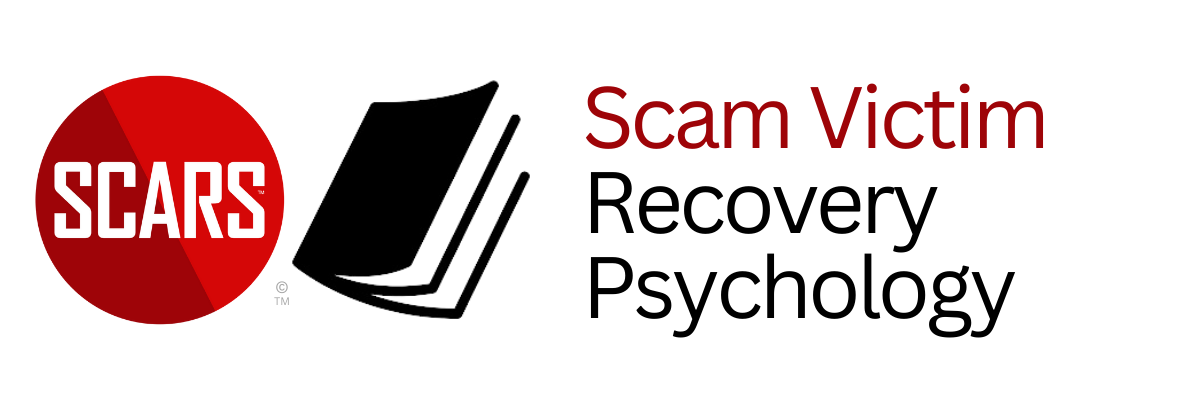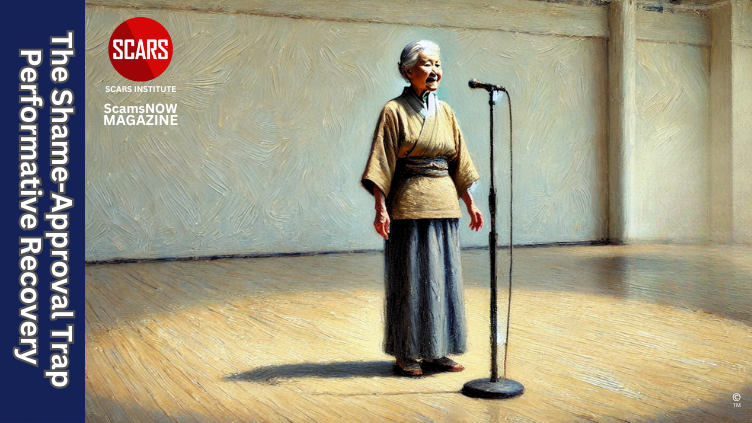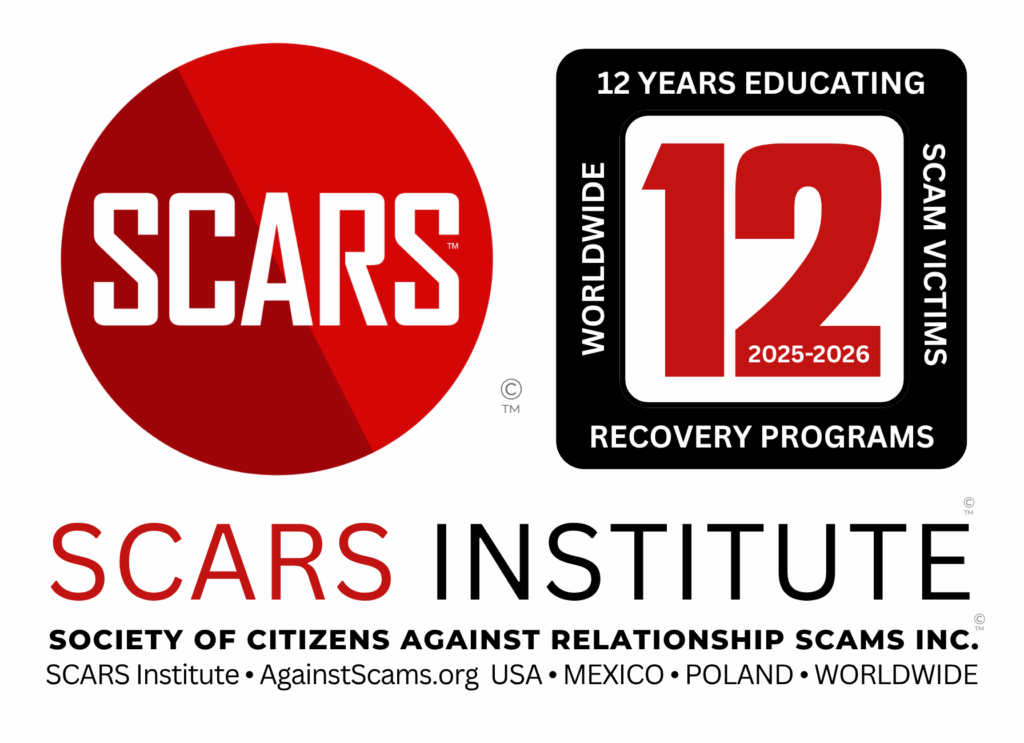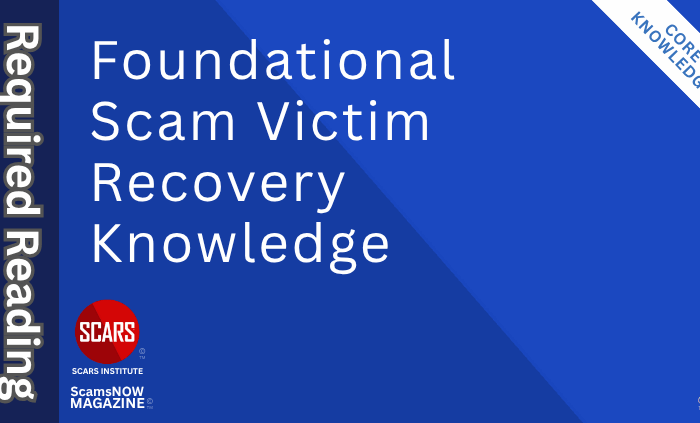
The Shame-Approval Trap & Performative Recovery
How the Need for External Validation Delays Recovery and Can Result in Performative Recovery
Primary Category: Scam Victim Recovery Psychology
Author:
• Tim McGuinness, Ph.D., DFin, MCPO, MAnth – Anthropologist, Scientist, Polymath, Director of the Society of Citizens Against Relationship Scams Inc.
About This Article
The Shame-Approval Trap is a common but damaging pattern that delays your recovery after trauma. Whether you are healing from a scam, abuse, or other emotional harm, the pressure to “look recovered” often leads you to perform strength for approval rather than face your real emotions.
While external validation may feel good in the moment, it reinforces shame and prevents honest healing. Lasting recovery requires you to shift your focus away from appearances and toward internal stability, self-reflection, and emotional processing.
When you stop performing for others and start building resilience from within, you create space for deeper healing, emotional strength, and genuine self-worth.
Advocates and support groups can help by creating safe spaces where vulnerability is respected and honest conversations replace superficial praise. You deserve recovery built on truth, not performance, and that starts by letting go of unrealistic expectations and focusing on your emotional growth.
Note: This article is intended for informational purposes and does not replace professional medical advice. If you are experiencing distress, please consult a qualified mental health professional.

The Shame-Approval Trap: How the Need for External Validation Delays Recovery and Can Result in Performative Recovery
Understanding the Shame-Approval Trap
Recovery after a scam is never a simple or straight path. You will experience emotional setbacks, doubts, and moments where healing feels impossible. During this vulnerable period, you may face pressure to present yourself as strong, composed, or “over it.” That pressure can come from your family, your social circles, or even your own expectations. The result is often the same. You start performing recovery to gain approval from others, instead of focusing on real emotional progress.
This pattern is called the Shame-Approval Trap. It describes the tendency to try to look recovered or prove strength to gain external validation, whether from other victims, support groups, family, or friends. At first, this may seem harmless or even helpful. You might believe showing strength will build confidence or prevent others from judging you. In reality, that performance creates a false sense of stability that keeps you from real emotional healing. This is not one of those situations where “fake it until you make it” works.
Wanting validation after trauma is a normal human reaction. You want to feel accepted, respected, and believed. That is understandable. The problem comes when you depend on outside approval as the only sign that you are making progress. When that happens, you delay the internal work you actually need for lasting recovery. Surface-level performances will never replace deep emotional processing, honest reflection, or structured healing. The first step to breaking out of this trap is recognizing it. When you understand this pattern, you can start focusing on real recovery instead of trying to meet unrealistic expectations.
How Shame and External Validation Become Linked
Shame is one of the strongest emotional responses you face after scam victimization, yet you may not fully understand how it shapes your recovery. The experience of being deceived, manipulated, or betrayed strikes directly at your sense of worth, confidence, and identity. You probably feel embarrassed, humiliated, or convinced that you should have seen the warning signs. Even though the blame belongs entirely to the criminal, you still internalize feelings of failure. That shame quietly starts to shape your behavior and choices long after the scam ends.
Shame creates a powerful need to protect your image and sense of control. When you feel ashamed, your instinct is to project strength, intelligence, or confidence to the outside world. You try to look unaffected, especially when you sense judgment or misunderstanding from family, friends, or even support groups. Unfortunately, many people still believe the myth that scam victims are careless or naïve. When you pick up on those attitudes, your shame deepens, and your urge to prove strength only grows stronger.
Your natural desire for external validation increases when shame takes hold. After going through trauma, you want reassurance from others to feel stable and in control again. Praise, approval, or recognition from those around you can give you temporary relief from the uncomfortable feelings of self-doubt or embarrassment.
For example, you might join a support group or open up to a friend but downplay your emotional pain to appear more composed. If someone compliments your strength or resilience, it gives you a short-lived boost of confidence.
While that validation feels good in the moment, it also reinforces a dangerous pattern. Over time, you may start depending on approval from others as the only measure of progress. Instead of focusing on your own emotional health, you become preoccupied with how others perceive you. If you appear strong, you convince yourself that you are recovering. If you show vulnerability or admit you are struggling, you fear rejection or criticism. This mindset keeps your deeper emotions buried and delays real healing.
Shame also pushes you to avoid situations where your vulnerability might be exposed. You may hesitate to share honest details about your grief, fear, or confusion because you worry it will make you look weak or incapable. Instead, you present an image of confidence that hides the pain you are still carrying. That performance may be convincing to others, but it leaves you feeling isolated and disconnected from meaningful support.
This link between shame and the need for approval often develops without you even noticing. You are not trying to deceive others or ignore your pain. You fall into this pattern because it feels like protection. Performing strength helps you avoid judgment, feel a sense of control, and experience temporary relief. The problem is, it keeps you from fully acknowledging the deeper emotional wounds the scam left behind.
The longer you stay in this pattern, the harder it becomes to break. You feel trapped between the image you show the world and the emotional reality you face privately. You fear that admitting the truth will disappoint people or destroy the strength you worked so hard to display. Yet, without honest reflection and emotional processing, the shame stays beneath the surface, triggering more self-doubt, anxiety, and unresolved grief.
Understanding how shame and external validation become linked is critical to your recovery. You need to recognize that approval from others, while comforting temporarily, cannot replace the hard but necessary work of internal healing. You benefit most from being in spaces where vulnerability is respected, setbacks are normalized, and emotional honesty is encouraged.
Breaking the connection between shame and the need for validation requires patience and self-awareness. You must learn to measure your progress by your emotional stability, your resilience, and your ability to face discomfort, not by how others react to you or the appearance of strength you project. When you shift your focus from external approval to your own growth, you make space for deeper, lasting recovery. That process allows you to rebuild real self-worth based on honest reflection, emotional strength, and confidence that comes from within, not from temporary performances designed to cover your shame.
How This Pattern Can Begin with Past Trauma
The Shame-Approval Trap usually does not start with the scam itself. If you find yourself caught in this pattern, it often has deeper roots tied to earlier life experiences. Unresolved trauma from childhood, family dysfunction, or abusive relationships can quietly shape how you respond to emotional pain, betrayal, or rejection. These past experiences create long-lasting patterns of shame, insecurity, and the constant need to seek approval to feel protected.
When you experience trauma early in life, especially during childhood, it often damages your sense of self-worth. If you grew up in an unstable, critical, or neglectful environment, you may have developed the belief that you were not good enough, smart enough, or lovable as you were. In those situations, you likely learned to cope by performing for approval. You may have tried to look strong, successful, agreeable, or unaffected by hardship. Over time, this coping mechanism became automatic.
Relationship abuse or emotional manipulation later in life can also reinforce these same patterns. When you endure controlling or toxic relationships, you often suppress your feelings to avoid rejection or conflict. You become highly aware of how others see you and rely on approval to feel temporarily safe or valued. Even when those harmful relationships end, the habit of protecting yourself through performance usually stays with you.
When this is part of your history, you carry unresolved shame into new life experiences. You may feel unworthy, broken, or flawed, but you hide those feelings behind an image of strength or competence. When a scam happens to you, it often strikes directly at those old insecurities. The betrayal, deception, and financial loss seem to confirm your deepest fears that you are weak, incapable, or unworthy. When that happens, you fall back into survival patterns you already know, turning to external approval to cover the doubt inside you.
If you have experienced rejection in the past, especially from caregivers, teachers, or intimate partners, you may feel even more sensitive now to how others see you. You may fear criticism, judgment, or abandonment if you show vulnerability. Instead of risking that, you perform recovery by projecting strength, control, or confidence. Even though that may help you avoid short-term discomfort, it keeps you from processing the real emotional damage beneath the surface.
Scam trauma often reignites these older patterns in powerful ways. The shock of being deceived brings back the shame, helplessness, or failure you may have carried for years. If you have a history of unhealed trauma, these emotions can feel overwhelming. Your instinct may be to hide, protect your image, and seek approval to feel like you are back in control. The problem is, that only delays your recovery and pushes you further into the Shame-Approval Trap.
Recognizing how your past trauma shapes your present behavior is the first step toward breaking this pattern. You need to understand that your need for approval, while normal, often comes from old wounds that have not yet healed. When you face those deeper patterns, you can start replacing performance with honest reflection, emotional processing, and genuine self-worth that does not depend on how others see you.
Lasting recovery does not come from approval. It comes from within you. When you stop relying on outside validation and begin valuing your own growth, your stability, and your ability to face discomfort, you finally create space for real healing. This shift frees you from the limits of past trauma and helps you step out of the approval-driven habits that have held you back for too long.
The Signs of the Shame-Approval Trap in Recovery
It is easy to fall into the Shame-Approval Trap without realizing it. After going through deception, betrayal, and emotional collapse, your instinct is to look for ways to regain control and restore your confidence. You may feel pressure to appear strong, composed, or unaffected. That pressure can lead to subtle behaviors that delay real healing. At first, these behaviors may feel like coping mechanisms, but over time, they quietly become barriers that hold you back from emotional progress.
Trying to “Look Recovered” to Avoid Vulnerability
One of the most common signs of this trap is trying to “look recovered” even though you are still struggling beneath the surface. Instead of expressing your fears, doubts, or setbacks, you present a version of yourself that looks emotionally detached or overly cheerful. You project this image to shield yourself from judgment, criticism, or embarrassment.
You may smile, engage in conversations, or speak confidently about your recovery while privately feeling overwhelmed or broken. You probably convince yourself that appearing strong will help you heal faster or avoid difficult conversations. In reality, hiding vulnerability delays your ability to process emotions. It keeps you stuck with unresolved grief, anger, and self-doubt that come with scam trauma.
This pattern often shows up in support groups, family settings, or among friends, where you feel pressured to prove you are “over it.” You may downplay your struggles, avoid conversations about setbacks, and only focus on positive statements. On the surface, this creates the illusion that you are making progress. But underneath, it leaves your emotional wounds untouched. Over time, this avoidance builds frustration, emotional exhaustion, and resentment toward yourself for not feeling as strong as you appear to others.
Over-Focusing on Social Approval
Another clear sign of the Shame-Approval Trap is over-focusing on external approval as your measure of recovery. When you are caught in this cycle, you tend to look for praise, reassurance, or validation from others. You may find yourself craving compliments about your strength, your ability to “move on,” or how well you appear to be handling your situation.
The problem is, this creates a distorted picture of your progress. Instead of judging your recovery based on your emotional health, internal stability, or personal growth, you start relying on how others react to you. If people praise you or recognize your strength, you feel a temporary sense of success. If they criticize you, ignore your efforts, or fail to acknowledge your progress, your self-doubt increases, and your shame resurfaces.
Support groups, online spaces, or conversations with friends and family can unintentionally reinforce this pattern. Well-meaning comments like, “You seem so strong” or “I can’t believe how well you’re handling this,” can push you to keep performing, even when you are struggling inside. You may avoid sharing difficult emotions because you fear disappointing others or losing the approval you have worked hard to earn.
Over time, this dependence on approval becomes a wall between you and honest recovery. You filter your emotions to match what you believe others want to see. You avoid your real vulnerabilities, limit your ability to process the trauma, and keep your self-worth attached to how unpredictable other people can be.
Suppressing Honest Emotions
The most damaging sign of the Shame-Approval Trap is when you suppress honest emotions altogether. When you are stuck in this trap, you avoid confronting your grief, anger, shame, or fear. Instead of expressing those feelings, you perform recovery. You appear emotionally stable, even though you are ignoring the pain that remains under the surface.
This suppression usually comes from your fear of being seen as weak, broken, or incapable. You worry that admitting your emotional struggles will confirm your worst beliefs about yourself or invite judgment from others. To avoid that, you stay quiet about your feelings, keep conversations shallow, and project confidence you may not feel at all.
The longer you bury these emotions, the more they affect you. Unprocessed grief does not disappear. Anger turns into frustration, and shame keeps chipping away at your self-esteem. You may notice increased anxiety, emotional numbness, or feel disconnected from your true self. That disconnection grows the longer you silence your emotions.
Suppressing your feelings also limits the value of support resources. Support groups, therapy, and trusted relationships only help when you engage with them honestly. When you refuse to show your real emotions, you miss out on opportunities for growth, understanding, and meaningful recovery.
The first step to breaking the Shame-Approval Trap is learning to recognize these signs in yourself. You need to create space where vulnerability is welcome, setbacks are treated as part of the process, and emotional honesty is respected. Recovery will never come from how you appear. Real healing requires the courage to face uncomfortable emotions and the patience to rebuild your confidence from within. When you stop performing and allow yourself to engage with honest emotional work, you finally create space for true healing and long-term resilience.
How Predators and Narcissists Exploit the Shame-Approval Trap
The Shame-Approval Trap is not just an internal struggle. It increases your risk of being targeted again by predators, narcissists, and other manipulative individuals. People who exploit others often recognize emotional weakness quickly, especially when they sense that someone craves reassurance, validation, or approval to feel secure. When you are stuck in this trap, you may unintentionally project those vulnerabilities, making yourself an easier target for emotional, financial, or psychological manipulation.
Predators, including scammers, abusers, and narcissists, know how to spot individuals who depend on external approval. They look for signs that you are performing strength while covering insecurity. When you try to appear strong, confident, or unaffected, but you are still carrying shame or self-doubt, you may think you are protecting yourself. In reality, predators see this as an opportunity.
Narcissists, in particular, use this pattern to their advantage. They often begin by offering exaggerated compliments, false admiration, or promises that they truly understand and respect you. They mirror your desire to look strong or in control and feed your need for reassurance. You may not realize it, but they are not impressed by your strength. They are using it as a doorway to influence you.
Scammers operate the same way. Romance scammers, fake investment schemes, or fraudulent business offers often start with flattery and attention. The scammer positions themselves as the one person who truly sees your intelligence, potential, or resilience. They use praise to lower your defenses, bypass skepticism, and fast-track emotional trust. When you are stuck in the Shame-Approval Trap, this feels comforting because it supports the image you are trying to maintain. It makes you believe you are in control when, in fact, they are controlling the situation.
Once they have your trust, predators increase their influence. Narcissists may start using subtle criticism, manipulation, or isolation to deepen your dependency. Scammers often create fake crises or exaggerated opportunities to pull you further into the scheme. Through it all, you stay focused on maintaining the illusion of strength and approval, rather than questioning their intentions or protecting yourself.
The need for approval also makes it harder to see red flags. When you crave reassurance from others, especially after a scam, you are more likely to overlook warning signs, rationalize suspicious behavior, or convince yourself everything is fine as long as you feel validated. This is one of the most dangerous effects of the Shame-Approval Trap. You may tell yourself the compliments are genuine, the connection is real, or that ignoring your doubts will protect your pride. All the while, you are giving someone else control over your emotions and your decisions.
If you have a history of unhealed trauma, this risk becomes even greater. Childhood neglect, emotional abuse, or toxic relationships can leave behind insecurities that make you even more desperate for approval. When someone offers attention, admiration, or flattery, it feels familiar. You may confuse manipulation for genuine connection. Scam trauma often reignites these patterns, making you more vulnerable to predators even while trying to recover.
This danger extends beyond personal relationships. Manipulative individuals operate in support groups, social spaces, workplaces, and online communities. They present themselves as allies, mentors, or trustworthy connections, but their real goal is control. If you crave approval, they can use that against you. You may believe they are helping when they are really reinforcing your dependence on their praise.
Recognizing how predators and narcissists exploit your need for approval protects you from future harm. You have to understand that craving validation is normal, especially after trauma, but it also creates predictable vulnerabilities. The solution is not to isolate yourself but to build internal confidence that does not rely on outside praise.
You need to evaluate new relationships, offers, or opportunities based on consistent behavior, respect, and honesty, not based on how much attention you receive. Building boundaries, slowing down trust, and questioning flattery are essential tools to avoid manipulation. Real recovery happens when you measure your progress by emotional stability, not public appearance.
As you work through recovery, remind yourself that your worth is not tied to how others react to you. Strength comes from your ability to be honest, to set limits, and to walk away from people who try to control you through praise. You can protect yourself by building resilience that comes from within, not from the temporary comfort of approval.
Advocates play an important role in reminding you of this. A good support system will never reward performance or surface-level strength. They will help you recognize the risks of depending on others for validation and encourage honest conversations. You deserve to feel confident in your recovery, but that confidence needs to come from your own growth, not manipulation.
When you understand how predators and narcissists exploit your need for approval, you take away their advantage. You begin to protect yourself by relying on your own judgment, building emotional strength, and choosing connections that are based on respect, not control. Breaking the Shame-Approval Trap keeps you safe and gives you the freedom to build healthier, more authentic relationships in the future.
How Performing Recovery Delays Genuine Healing
After a scam, you may feel pressure to look strong, confident, or unaffected. You want to believe that projecting strength will help you heal faster or keep others from judging you. This often leads to performing recovery rather than living it. The problem is, when you focus on appearances instead of honest emotions, you delay the healing process and stay stuck beneath the surface.
How False Appearances Block Emotional Processing
When you perform recovery, you create an image of progress that may seem believable to others, but it prevents you from facing your real emotions. You might smile, talk about moving forward, or tell people you are doing fine, even though you feel overwhelmed inside. This creates a gap between what you show others and what you experience privately.
That false appearance can block your ability to process the grief, anger, and shame that come with scam trauma. You cannot work through those feelings if you are focused on convincing others, or yourself, that you are already past the pain. Emotional healing depends on honesty. It requires facing your doubts, fears, and setbacks, not hiding behind an image that looks strong but leaves your real struggles untouched.
How Unaddressed Shame Festers Beneath the Surface
When you perform recovery to gain approval, the shame you carry remains unresolved. You might look composed on the outside, but beneath that surface, the feelings of failure, embarrassment, and self-blame grow stronger. The longer you avoid addressing those emotions, the deeper they settle into your mindset.
Unaddressed shame becomes a constant background weight. It affects how you see yourself, how you interact with others, and how much progress you believe is possible. You might convince yourself that appearing strong protects you, but inside, the shame continues to erode your confidence. True healing requires facing that shame directly, processing the emotions, and building self-worth that is not dependent on outside approval.
How Suppressing Emotions Leaves You Isolated
Another hidden consequence of performing recovery is isolation. When you suppress your real emotions, you separate yourself from meaningful support. Friends, family, or support groups may believe you are doing well, so they offer fewer opportunities for deeper conversations or emotional help. You end up feeling disconnected, even when you are surrounded by people.
Suppressing your emotions also makes it harder to trust others. You worry that if you reveal your doubts, fears, or setbacks, people will judge you or see you as weak. That fear keeps you silent, which only increases the sense of isolation. Real support happens when you share honestly, even when the emotions are uncomfortable.
When you stop performing recovery and start engaging with your emotions, you create space for real connection. You give yourself permission to process your grief, anger, and self-doubt without shame. You also allow others to support you in meaningful ways, which builds trust, reduces isolation, and helps you move forward with real emotional strength.
Performing recovery may feel safer at first, but it delays your healing. You deserve more than surface-level strength. Honest reflection, emotional processing, and connection are what lead to genuine recovery. When you focus on those steps, you break the pattern of performing for approval and create space for lasting healing.
The Shame-Approval Trap Across Other Victimologies
The Shame-Approval Trap is not unique to scam victims. You will see this same pattern show up in people recovering from other types of trauma. Whether you have experienced domestic abuse, sexual assault, violent crime, or childhood abuse, the need to look strong and gain approval often appears in the recovery process. The pressure to perform strength affects people from all backgrounds, and it slows down real healing in every case.
When you go through trauma, your confidence and sense of safety break down. You feel exposed, vulnerable, and often ashamed. Even though you are not to blame for what happened, shame becomes a powerful part of your emotional experience. To cope with that shame, many survivors try to project strength, stability, or emotional control. You might do this without even realizing it, thinking that looking unaffected will help you heal faster or protect you from judgment.
Domestic Abuse Survivors
If you have been in an abusive relationship, you know how complicated recovery feels. You carry shame from the relationship itself, especially if people around you question why you stayed or why you did not see the warning signs. That shame can push you into performing recovery. You may act like you have moved on, pretend to feel confident, or avoid talking about the emotional damage, all to prove that you are strong.
The problem is that performing strength keeps you from processing the deeper impact of the abuse. The grief, self-doubt, and fear remain beneath the surface. You convince yourself that appearing strong will protect your image, but it actually delays healing. Recovery from domestic abuse requires honesty, self-compassion, and space to confront painful emotions, not the constant performance of strength.
Sexual Assault Survivors
Survivors of sexual assault often experience overwhelming shame, even though they are never responsible for what happened. That shame often comes from the way society judges victims or how survivors judge themselves. You may feel pressure to prove that you are unaffected, that you are still strong, or that the experience has not changed how you see yourself.
When you perform that strength for others, you push aside the emotions that need your attention. You may avoid sharing your fears, your anger, or your sense of betrayal. Over time, that avoidance builds walls between you and real recovery. You deserve to heal without having to project an image of control. Real strength comes from facing the hard emotions, not from hiding behind appearances.
Violent Crime Survivors
If you have survived a violent crime, whether it was robbery, assault, or another traumatic event, you may feel embarrassed or ashamed that you could not prevent it. Society often rewards people who appear tough or unaffected, so you may fall into the habit of looking resilient, even when you feel shaken inside.
When you perform recovery after violent crime, you limit your ability to rebuild your emotional security. You might look calm or confident, but the anxiety, anger, or trauma stays beneath the surface. Honest recovery means processing those emotions, even when it feels uncomfortable. Projecting strength only delays that progress and keeps you stuck in the Shame-Approval Trap.
Childhood Abuse Survivors
Survivors of childhood abuse often carry shame from early life experiences that shaped how they see themselves. You may have learned to hide vulnerability as a form of protection long before you understood your emotions. That pattern can stay with you into adulthood, especially after new trauma.
If you experienced abuse as a child, you might feel pressure to prove that you are independent, unaffected, or emotionally strong. You may avoid sharing your past, downplay your struggles, or suppress your real feelings. Performing recovery may feel like survival, but it prevents you from facing the long-term emotional damage and slows down your ability to heal.
Advocates Must Learn to Recognize the Pattern
If you support other trauma survivors, you need to understand how common the Shame-Approval Trap is across all types of victimization. You will see this in scam victims, domestic abuse survivors, sexual assault survivors, violent crime victims, and people healing from childhood abuse. The instinct to perform strength often appears the same, no matter the type of trauma.
You need to look beyond appearances. When survivors act confident, controlled, or emotionally detached, it does not always mean they are recovering. Sometimes, those behaviors are performances driven by shame and fear. You cannot push people to “move on” or expect strength without creating space for honest emotions.
The most effective support comes from helping survivors process their feelings without judgment. Encourage them to express doubts, setbacks, or fears. Help them see that real recovery takes time, and strength does not come from hiding emotions. It comes from working through them with patience and honesty.
The Shame-Approval Trap can delay healing for anyone, regardless of the type of trauma. You need to recognize it, both in yourself and in the people you support. When you stop performing strength and start focusing on emotional processing, you create space for real, lasting recovery. No matter what type of trauma you have faced, the path to healing requires honesty, not appearances.
Breaking the Trap: Shifting from Performance to Authentic Recovery
When you get stuck in the Shame-Approval Trap, your recovery slows down. You spend more time managing appearances than facing your real emotions. You start measuring your progress based on how strong you look, not how stable you feel. Over time, this creates frustration, isolation, and deeper emotional exhaustion. The only way to break this cycle is to shift away from performing recovery and focus on building honest, lasting healing. You do not need to prove anything to anyone. You only need to reconnect with yourself and your emotions in a way that allows real progress.
Step 1: Acknowledge Shame Responses Without Judgment
The first step in breaking this trap is recognizing your shame responses without attacking yourself. You are not weak for feeling shame. You are not flawed because you care how others see you. These are normal human reactions after trauma. The problem starts when you let those reactions control your behavior and keep you from facing what needs your attention.
When you notice yourself craving approval or avoiding vulnerability, pause and acknowledge it. Say to yourself, “I am feeling ashamed right now,” or “I am worried about how others see me.” This is not about criticizing yourself. It is about recognizing the emotional response and giving yourself permission to face it honestly.
The more you can observe your shame without judgment, the easier it becomes to choose different reactions. You can still feel ashamed, but decide not to perform recovery to hide it. You can allow the discomfort without letting it dictate your behavior. That self-awareness weakens the trap and gives you space to approach recovery differently.
Step 2: Focus on Internal Progress, Not Appearances
To break the Shame-Approval Trap, you need to shift your focus from how you appear to how you feel inside. It is easy to believe that if you look strong, you are healing. But real recovery has nothing to do with appearances. It happens when you face your emotions honestly, even when they are uncomfortable or messy.
Start measuring your progress based on your internal stability, not on compliments or outside approval. Ask yourself questions like, “Am I processing my grief?” or “Am I feeling less overwhelmed than before?” Your goal is not to project confidence. Your goal is to rebuild emotional strength from the inside out.
This shift requires patience. You may not always feel strong. You may still struggle with self-doubt or setbacks. That is part of recovery. When you stop trying to control how others see you and start focusing on your emotional growth, you create the space for real healing to happen.
Step 3: Seek Safe, Structured, Trauma-Informed Support
Recovery is not something you should do alone. You need safe, structured, and trauma-informed support to guide you through this process. If you surround yourself with people who expect performances of strength, you will fall back into the trap. If your support environment encourages honesty, vulnerability, and patience, you will heal more effectively.
Look for support systems where your emotions are respected, even when they are uncomfortable. This can include reputable support groups, professional counseling, or trusted individuals who understand trauma recovery. You should never be forced to “look recovered” to be accepted in these spaces. Real support helps you process your feelings, not hide them.
Trauma-informed support also helps you identify the habits that keep you stuck. A good advocate or therapist will point out when you are performing recovery and help you replace those patterns with healthier responses. You need people in your corner who challenge the false belief that looking strong means you are healed.
Step 4: Normalize Setbacks as Part of Recovery
Breaking the Shame-Approval Trap also means accepting that setbacks happen. You will not heal in a straight line. You will have days when you feel strong and days when you feel overwhelmed. That is not failure. That is how recovery works.
When you believe that strength means never struggling, you create unrealistic expectations that keep you performing recovery. You hide your bad days. You pretend to be fine when you are not. That keeps the shame alive and prevents real progress.
You need to remind yourself that emotional ups and downs are part of healing. Feeling anxious, grieving, or having setbacks does not mean you are weak. It means you are processing what happened to you. The more you accept that recovery takes time, the less pressure you feel to perform for others.
You will make mistakes. You will feel ashamed sometimes. You will have days when you want to hide your struggles. That does not mean you are stuck. It means you are human. When you normalize those setbacks, you give yourself permission to keep going without falling back into the trap of appearances.
Breaking the Shame-Approval Trap requires honest self-awareness, patience, and the courage to shift your focus away from approval and toward real emotional growth. You deserve recovery that is rooted in stability, self-worth, and authentic healing, not performances designed to protect your image.
When you stop measuring your progress by how others see you and start focusing on your internal strength, you create space for long-term healing. You can process your emotions, build resilience, and reconnect with yourself in a way that feels real. Recovery is not about how strong you look. It is about how stable and grounded you feel, even on your hardest days. That is the foundation of lasting emotional health.
The Role of Advocates in Breaking the Shame-Approval Cycle
If you support scam victims or other trauma survivors, your words and actions shape how people approach recovery. You have the power to create a space that encourages honest healing, or you can unintentionally push people deeper into the Shame-Approval Trap. Many advocates focus on strength, resilience, and visible signs of recovery, thinking this motivates victims. In reality, when you only praise appearances, you make it harder for people to be honest about their struggles.
The Shame-Approval Trap grows stronger when survivors believe they have to look recovered to earn support or respect. If you celebrate only surface-level strength, you reinforce the belief that vulnerability is weakness. You might think you are being helpful when you tell someone how strong they look or how well they seem to be handling things. But if that person is struggling privately, your praise can make them feel like they have to keep performing instead of asking for help.
Avoid Praising Only Visible Strength
You need to be careful with the messages you send as an advocate. If your praise focuses only on confidence, composure, or the ability to “move on,” you encourage survivors to hide their emotions. They may feel they cannot express fear, grief, or confusion because doing so would disappoint you or change how you see them.
You should still celebrate progress, but focus your encouragement on the person’s honesty and emotional work, not their image. Let them know it is okay to show vulnerability. Make it clear that true strength comes from facing difficult emotions, not hiding them behind appearances.
Validate Vulnerability and Allow Honest Conversations
One of the most important things you can do as an advocate is create space for emotional honesty. When someone tells you they are struggling, scared, or overwhelmed, validate their feelings. Remind them that these emotions are normal after trauma. Let them know they do not have to perform strength to earn your respect or support.
You should encourage conversations that go beyond appearances. Ask survivors how they are really feeling, not just how they look on the surface. When people feel safe to share setbacks and doubts, they are more likely to process their emotions and move forward in their recovery. Your role is to foster those honest conversations, even when they feel uncomfortable.
Build Group Cultures That Respect Emotional Honesty
If you lead or participate in support groups, you influence the culture of those spaces. You need to help create environments where emotional honesty is valued more than how strong someone appears. Groups that focus too much on resilience, confidence, or visible progress often silence the people who need the most help.
In your group, normalize conversations about setbacks, doubts, and fears. Remind people that recovery is not measured by how they look or sound. It is measured by their ability to process emotions, face vulnerability, and grow at their own pace.
You should model this by being honest about your own struggles or doubts when appropriate. When people see you respecting your emotions, they feel safer doing the same. Group cultures built on honest support help survivors avoid the Shame-Approval Trap and focus on building real stability.
As an advocate, your words and actions can either break the Shame-Approval Cycle or strengthen it. Survivors need your support, but they need it to be grounded in acceptance, honesty, and respect for their emotional process. You can help people move beyond appearances by validating vulnerability, encouraging real conversations, and building group cultures that prioritize emotional honesty.
Recovery happens when survivors feel safe to share their real emotions, not when they feel pressured to perform strength. You have the power to create that safety. When you do, you help survivors escape the trap of approval-driven recovery and guide them toward lasting healing built on truth, resilience, and self-acceptance.
Conclusion
When you face the damage left behind by a scam, it is easy to focus on how others see you. You want to look strong, confident, and unaffected. You want people to believe you are recovering, even when you feel lost or overwhelmed. That is how the Shame-Approval Trap begins. You start performing recovery to earn approval, but underneath the surface, the real emotional wounds stay untouched.
You need to remind yourself that authentic healing does not happen through appearance. It happens when you face your emotions honestly, even when they are uncomfortable. Lasting recovery comes from processing your grief, your fears, your shame, and your self-doubt, not from hiding them. The image you project to others does not determine your progress. The work you do within yourself is what builds real strength and stability.
Escaping the Shame-Approval Trap frees you to grow emotionally. When you stop depending on approval or praise, you can focus on your own healing. You will still feel shame at times. You will still struggle with self-doubt. That is part of recovery. The difference is, you will not let those feelings control your behavior. You will stop performing for others and start building real resilience from within.
Choosing recovery over performance gives you space to accept your setbacks, your bad days, and your emotional challenges without judgment. You can stop worrying about how strong you look and focus on how stable you feel. That mindset builds the foundation for long-term healing and emotional strength that lasts beyond appearances.
Advocates and support systems also play a role in breaking this cycle. If you support other survivors, encourage them to focus on honest emotional progress. Help them see that looking strong is not the goal. Feeling grounded, processing emotions, and building self-worth from within is what matters most. You create safer, more supportive spaces when you value vulnerability over image.
Whether you are recovering from scam trauma or helping others through it, your focus should stay on internal progress. You do not need to perform recovery to prove your worth. You do not need to hide your struggles to earn respect. You need to face your emotions honestly, take steady steps forward, and remind yourself that real healing happens beneath the surface. When you let go of the need to perform, you finally give yourself permission to heal on your terms. That is where true resilience begins.
Please Rate This Article
Please Leave Us Your Comment Below
Also, tell us of any topics we might have missed.
-/ 30 /-
What do you think about this?
Please share your thoughts in a comment above!
ARTICLE RATING
TABLE OF CONTENTS
CATEGORIES
U.S. & Canada Suicide Lifeline 988
![NavyLogo@4x-81[1] The Shame-Approval Trap - Performative Recovery - 2025](https://scamsnow.com/wp-content/uploads/2025/04/NavyLogo@4x-811.png)
ARTICLE META
Important Information for New Scam Victims
- Please visit www.ScamVictimsSupport.org – a SCARS Website for New Scam Victims & Sextortion Victims.
- SCARS Institute now offers its free, safe, and private Scam Survivor’s Support Community at www.SCARScommunity.org – this is not on a social media platform, it is our own safe & secure platform created by the SCARS Institute especially for scam victims & survivors.
- SCARS Institute now offers a free recovery learning program at www.SCARSeducation.org.
- Please visit www.ScamPsychology.org – to more fully understand the psychological concepts involved in scams and scam victim recovery.
If you are looking for local trauma counselors, please visit counseling.AgainstScams.org
If you need to speak with someone now, you can dial 988 or find phone numbers for crisis hotlines all around the world here: www.opencounseling.com/suicide-hotlines
Statement About Victim Blaming
Some of our articles discuss various aspects of victims. This is both about better understanding victims (the science of victimology) and their behaviors and psychology. This helps us to educate victims/survivors about why these crimes happened and not to blame themselves, better develop recovery programs, and help victims avoid scams in the future. At times, this may sound like blaming the victim, but it does not blame scam victims; we are simply explaining the hows and whys of the experience victims have.
These articles, about the Psychology of Scams or Victim Psychology – meaning that all humans have psychological or cognitive characteristics in common that can either be exploited or work against us – help us all to understand the unique challenges victims face before, during, and after scams, fraud, or cybercrimes. These sometimes talk about some of the vulnerabilities the scammers exploit. Victims rarely have control of them or are even aware of them, until something like a scam happens, and then they can learn how their mind works and how to overcome these mechanisms.
Articles like these help victims and others understand these processes and how to help prevent them from being exploited again or to help them recover more easily by understanding their post-scam behaviors. Learn more about the Psychology of Scams at www.ScamPsychology.org
SCARS INSTITUTE RESOURCES:
If You Have Been Victimized By A Scam Or Cybercrime
♦ If you are a victim of scams, go to www.ScamVictimsSupport.org for real knowledge and help
♦ SCARS Institute now offers its free, safe, and private Scam Survivor’s Support Community at www.SCARScommunity.org/register – this is not on a social media platform, it is our own safe & secure platform created by the SCARS Institute especially for scam victims & survivors.
♦ Enroll in SCARS Scam Survivor’s School now at www.SCARSeducation.org
♦ To report criminals, visit https://reporting.AgainstScams.org – we will NEVER give your data to money recovery companies like some do!
♦ Follow us and find our podcasts, webinars, and helpful videos on YouTube: https://www.youtube.com/@RomancescamsNowcom
♦ Learn about the Psychology of Scams at www.ScamPsychology.org
♦ Dig deeper into the reality of scams, fraud, and cybercrime at www.ScamsNOW.com and www.RomanceScamsNOW.com
♦ Scam Survivor’s Stories: www.ScamSurvivorStories.org
♦ For Scam Victim Advocates visit www.ScamVictimsAdvocates.org
♦ See more scammer photos on www.ScammerPhotos.com
You can also find the SCARS Institute’s knowledge and information on Facebook, Instagram, X, LinkedIn, and TruthSocial
Psychology Disclaimer:
All articles about psychology and the human brain on this website are for information & education only
The information provided in this and other SCARS articles are intended for educational and self-help purposes only and should not be construed as a substitute for professional therapy or counseling.
Note about Mindfulness: Mindfulness practices have the potential to create psychological distress for some individuals. Please consult a mental health professional or experienced meditation instructor for guidance should you encounter difficulties.
While any self-help techniques outlined herein may be beneficial for scam victims seeking to recover from their experience and move towards recovery, it is important to consult with a qualified mental health professional before initiating any course of action. Each individual’s experience and needs are unique, and what works for one person may not be suitable for another.
Additionally, any approach may not be appropriate for individuals with certain pre-existing mental health conditions or trauma histories. It is advisable to seek guidance from a licensed therapist or counselor who can provide personalized support, guidance, and treatment tailored to your specific needs.
If you are experiencing significant distress or emotional difficulties related to a scam or other traumatic event, please consult your doctor or mental health provider for appropriate care and support.
Also read our SCARS Institute Statement about Professional Care for Scam Victims – click here
If you are in crisis, feeling desperate, or in despair, please call 988 or your local crisis hotline.
More ScamsNOW.com Articles
A Question of Trust
At the SCARS Institute, we invite you to do your own research on the topics we speak about and publish. Our team investigates the subject being discussed, especially when it comes to understanding the scam victims-survivors’ experience. You can do Google searches, but in many cases, you will have to wade through scientific papers and studies. However, remember that biases and perspectives matter and influence the outcome. Regardless, we encourage you to explore these topics as thoroughly as you can for your own awareness.
























![scars-institute[1] The Shame-Approval Trap - Performative Recovery - 2025](https://scamsnow.com/wp-content/uploads/2025/04/scars-institute1.png)
![niprc1.png1_-150×1501-1[1] The Shame-Approval Trap - Performative Recovery - 2025](https://scamsnow.com/wp-content/uploads/2025/04/niprc1.png1_-150x1501-11.webp)
